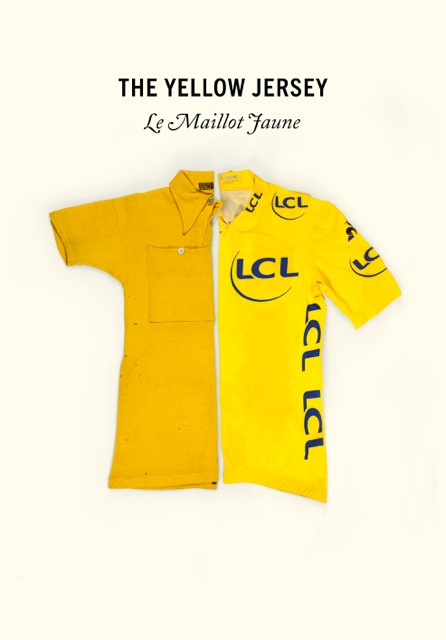Book Excerpt: The Yellow Jersey by Peter Cossins
'Exclusiveness is one of the primary characteristics of the yellow jersey'

Exclusiveness is one of the primary characteristics of the yellow jersey. Among the millions of spectators that line the roadsides at the Tour de France each year, only a handful will be seen in yellow. At the same time, you usually don’t have to travel too far along the Tour route to observe fans and cyclists decked out in polka dots or Peter Sagan green. According to Libération’s Pierre Carrey, ‘It is forbidden to wear the yellow jersey in France, for anyone to ride in it. It belongs to the Tour leader, and him alone. He’s like the Louis XIV, the Sun King, reincarnated in a cycling jersey.’
That might be the case in the modern era, but certainly wasn’t when Eugène Christophe first modelled the yellow jersey in Grenoble in July 1919. Rather than feeling regal, the Frenchman was embarrassed, a figure of fun. Mocked by his fellow racers and spectators as 'the canary', he also had to endure taunts about his wife's fidelity, as cuckolds were often caricatured wearing yellow cloaks or scarves. Funny perhaps, offensive definitely, these barbs highlighted the general antipathy towards the colour yellow that can be traced back more than a thousand years and persisted well into the twentieth century, when it was transformed by its significance within sport and by the Tour in particular.
'The yellow jersey has contributed to a re-evaluation of a colour that did have a bad reputation for a long time,' says Michel Pastoureau, a professor of medieval history at the Sorbonne in Paris, who is an expert in Western symbology and renowned within France for his books on the history of the colours red, blue, black and green – he has his own feelings of reticence about yellow, and has yet to dedicate himself to publication of an extended work on this colour.
Interviewed by Ouest France, Pastoureau explains there isn’t a definitive answer to the question of why yellow attracted such disfavour, but he and other experts suggest that it may stem from the unreliability of yellow dyes and paint in the Middle Ages. Produced using the bright yellow flowers taken from broom as the base, these yellows didn’t penetrate fabric, canvas and other materials very well and, as a consequence, tended to fade comparatively quickly. More resistant yellows could be made using saffron, but the spice imported from Asia was expensive and only available to richer members of society, reinforcing the exclusiveness of the colour. The yellowness of sulphur and the chemical’s association with the devil and all things diabolical is another reason for this distaste.
While other colours maintained a balance of good and bad associations, these negative aspects became inextricably associated with yellow, while the colour’s more positive attributes attained a more golden hue. ‘Gold acquired all of the good aspects of the colour (heat, light, wealth, power) and left yellow with the bad parts,’ Pastoureau explains. ‘For a long time in the West, yellow’s symbolism was more negative than positive. It was the colour of sickness, of autumn. The colour of lies, of deceit, of treason. The colour of Judas.’
The change came gradually. In Roman times, yellow often featured in clothes worn at weddings and other important ceremonies. In China, it was reserved for the emperor – the Sun King of his era – and regarded as a symbol of power, wealth and wisdom. In Europe, however, its significance gradually changed as it became increasingly linked with decline and deception.
In France, attitudes gradually began to change from the 1850s. Due in part to impressionist painters who focused on subjects and landscapes outside the artist’s studio, yellow became radiant and uplifting rather than denoting deceit and decay, most famously in the works of the Vincent van Gogh, where the wheat fields and sunflowers have an extremely luminous and joyful quality, which is echoed every year at the Tour in the emblematic photographs and images of the peloton passing between fields of dazzlingly vibrant blooms.
Get The Leadout Newsletter
The latest race content, interviews, features, reviews and expert buying guides, direct to your inbox!
Yet for most of the French population, unaware and untouched by impressionism and abstract art, yellow essentially retained the long-established negative motifs, illustrated by the barbs shouted Christophe’s way in Grenoble on that early morning when the first leader’s jersey was presented. Comic and satirical publications still depicted their villains in in yellow scarves and shawls.
The Yellow Jersey by Peter Cossins is published by Yellow Jersey Press.
Peter Cossins has written about professional cycling since 1993 and is a contributing editor to Procycling. He is the author of The Monuments: The Grit and the Glory of Cycling's Greatest One-Day Races (Bloomsbury, March 2014) and has translated Christophe Bassons' autobiography, A Clean Break (Bloomsbury, July 2014).